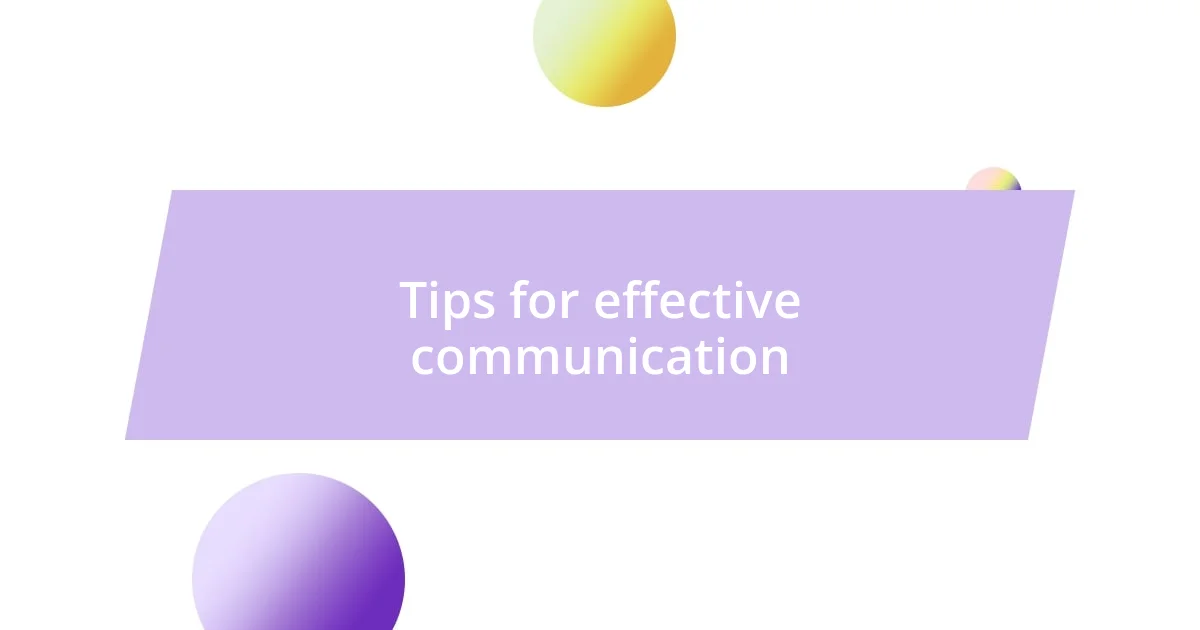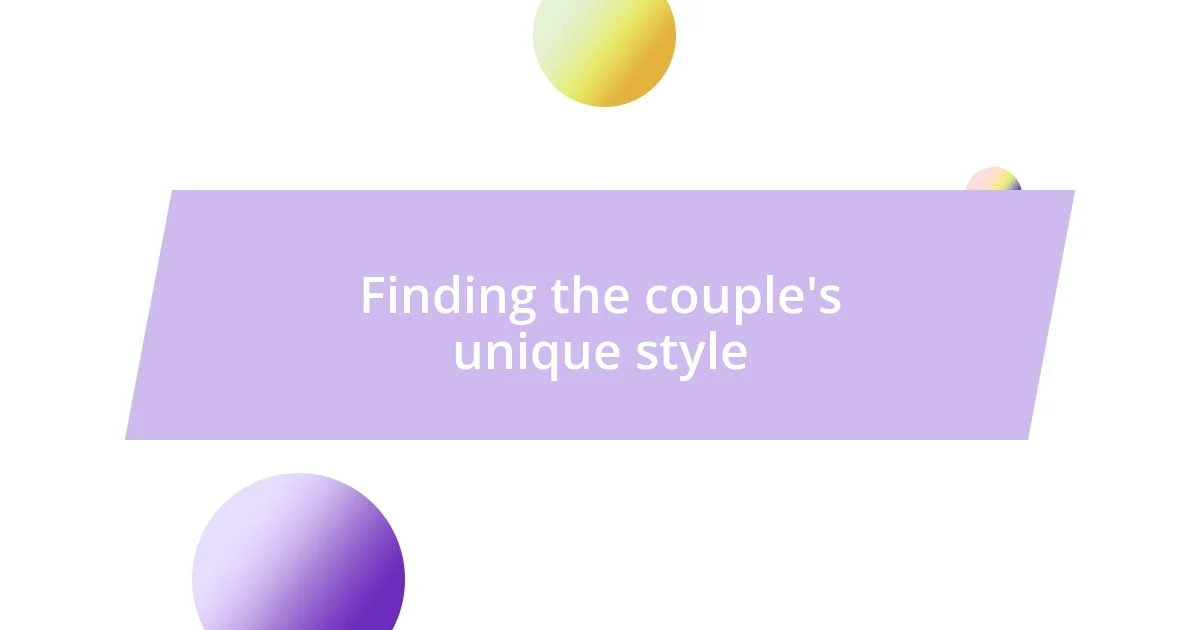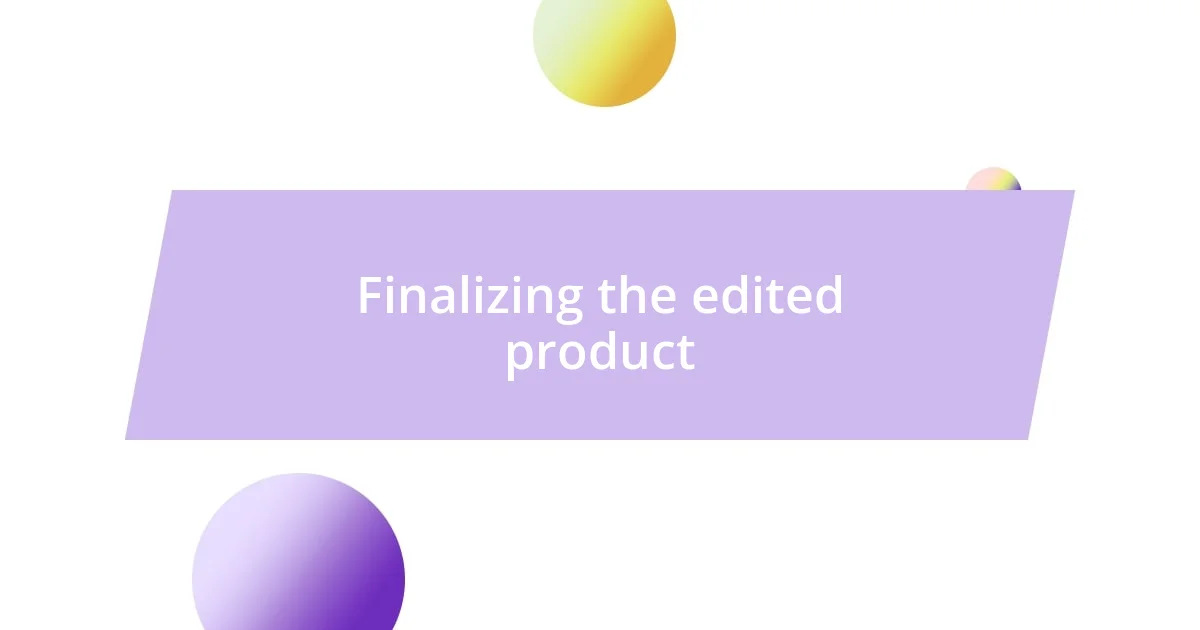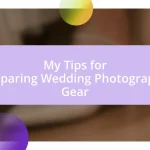Key takeaways:
- Effective communication, including active listening and creating a safe space for dialogue, is essential for couples during the editing process.
- Acknowledging each partner’s strengths and establishing clear roles improves collaboration and reduces confusion.
- Incorporating feedback and embracing differing perspectives can enhance creativity, leading to a richer final product and a stronger partnership.

Understanding couples editing process
Editing as a couple can be a complicated dance. I remember a time when my partner and I struggled to find common ground on a project. We each had our unique perspectives, which clashed at first, leading to misunderstandings. Have you ever felt that tension? It can be tough, but I found that acknowledging each other’s viewpoints created a collaborative atmosphere.
As we navigated this process, we discovered that communication was our lifeline. During our editing sessions, we set aside time to discuss our thoughts openly—no judgment, just sharing. This approach helped us not only refine our work but also deepen our understanding of each other’s creative instincts. Wasn’t it enlightening to see how feedback could foster intimacy?
Ultimately, learning to step back and assess our emotional responses allowed us to evaluate our edits objectively. I recall one instance when a piece we worked on felt too personal, and I had to remind myself to focus on the message rather than my emotional attachment. This practice not only improved our editing process but also strengthened our relationship. How do you balance emotion and objectivity in your collaborations?

Key elements for successful edits
Editing with a partner brings together diverse viewpoints, and acknowledging each other’s strengths is paramount. I remember a project where my partner excelled in structuring arguments while I was more focused on style. By recognizing our individual skills, we played to our strengths, which not only streamlined our process but also boosted our confidence. It’s rewarding to see how collaboration can elevate a joint effort.
Another key element in our successful edits has been establishing clear roles. Early on, we would tiptoe around tasks, leading to confusion about who was responsible for what. A memorable moment was when we finally designated specific aspects of our edits—like one of us focusing on content cohesion while the other handled grammar and punctuation. This clarity not only made our editing sessions smoother but also reduced friction—something I know many couples encounter. Have you ever felt that sense of relief when everyone knows their part?
Lastly, reflecting together after each editing session has become essential for us. We take a moment to discuss what worked, what didn’t, and what we can improve next time. I recall a session that turned into a much-needed debrief where we celebrated our small victories. This practice has fostered a sense of accomplishment and connection, transforming what could feel like mere work into a shared journey.
| Key Element | Description |
|---|---|
| Strengths Acknowledgment | Recognizing and leveraging each other’s unique skills enhances collaboration. |
| Clear Roles | Assigning specific tasks reduces confusion and improves accountability. |
| Post-Session Reflection | Discussing outcomes fosters connection and allows for continuous improvement. |

Tips for effective communication
When it comes to effective communication, I’ve learned the importance of creating a safe space where both partners can express their thoughts freely. One incident that sticks with me involved a delicate piece we were tackling. I noticed my partner hesitated to voice concerns about a section they felt was crucial. It was a simple moment, but understanding their reluctance reinforced my belief that openness, without fear of judgment, is vital. We evolved our editing sessions into a judgment-free zone, which made all the difference in our collaboration.
To enhance our communication further, we’ve adopted specific strategies that have worked wonders for us:
-
Active Listening: We practice truly hearing each other without interrupting. It may sound basic, but it shows respect for the other’s perspective.
-
I-Statements: Instead of saying “You don’t understand,” we express feelings with statements like “I feel frustrated when…”. This small shift reduces defensiveness and opens dialogue.
-
Scheduled Check-Ins: Setting aside time for structured conversations about our editing process helps us remain on the same page and keeps tensions low.
Through these practices, we’ve cultivated an environment of support and respect that reinforces our bond. It’s like nurturing a garden—every conversation is a seed, and with care, it blooms into a stronger partnership.
In my experience, maintaining a sense of humor during editing sessions has been an absolute game changer. There was a time my partner and I got so caught up in a tense debate over a single word choice. Frustration was building, and instead of letting it escalate, I jokingly compared our discussion to debating the merits of ketchup on a gourmet meal. It lightened the mood instantly, reminding us that we’re in this together. Laughter not only eases tension but also fosters a memorable bond through shared experiences.
Here are some more tactics to keep communication effective during editing:
-
Clarifying Questions: Instead of making assumptions, we ask questions like, “What do you mean by that?” It’s surprising how clarity can resolve confusion.
-
Frequent Affirmations: Acknowledging each other’s contributions helps build morale. A simple “I appreciate your insight” can go a long way.
-
Non-Verbal Cues: Sometimes, a nod or smile during discussions can communicate more than words. It reinforces that we’re engaged and supportive.
Creating an atmosphere where dialogue can flourish, infused with a bit of humor, has shaped our editing relationship in ways I never anticipated.

Finding the couple’s unique style
Finding a couple’s unique style in editing is all about understanding each other’s preferences and creative instincts. I recall a project where my partner gravitated towards a more traditional, structured approach, while I was drawn to a more free-flowing, experimental style. When we sat down and discussed our ideas openly, it was enlightening to discover how blending these different approaches could create something fresh and dynamic. Have you ever experienced that moment when you realize how contrasting styles can actually complement each other?
Exploring your combined aesthetic can also be a fun exercise. One time, we decided to create a mood board featuring elements that inspired us both—colors, fonts, quotes, you name it! It was such an enjoyable process that revealed our shared vision while also highlighting our differences. This collaborative activity not only enhanced our editing process but also deepened our understanding of each other’s tastes. Isn’t it fascinating how a simple visual representation can shape your editing style?
Ultimately, embracing open dialogue about your editing preferences is crucial. There have been times when I hesitated to share my thoughts, worried they might clash with my partner’s vision. But once I started voicing those feelings, we discovered that discussing our various styles didn’t lead to conflict; instead, it sparked creativity. The ability to articulate what resonates with us individually laid the foundation for a unique editorial voice, one that genuinely reflects both of us. Have you taken the time to explore what truly resonates with you as a couple?

Balancing differing perspectives
Balancing differing perspectives in editing can be a rewarding challenge. I remember a project where my partner felt strongly about the emotional tone of the piece, while I was focused on clarity and structure. Instead of viewing this as a clash, we chose to see it as an opportunity for growth. I suggested we write down our individual viewpoints and then come together to explore how these differing perspectives could weave together into a richer narrative. It was enlightening to see how our contrast sparked creativity rather than conflict.
Sometimes, it helps to step back and remind ourselves why we’re collaborating. I once found myself frustrated over my partner’s interpretation of a character’s motivation. Instead of insisting on my view, I asked, “What do you see that I’m missing?” This simple question opened up a deeper conversation about our emotional connections to the characters. It emphasized how crucial it is to listen genuinely. In moments like these, I realized that our differences could lead us to go beyond our comfort zones, offering insights we might have overlooked alone.
I’ve learned that finding common ground doesn’t mean compromising individuality. During a particularly heated discussion, I suggested we create a visual representation of our perspectives. We sketched out a Venn diagram showing where our ideas overlapped and where they diverged. This engaging exercise not only made the differing viewpoints tangible but also fostered appreciation for what each of us brought to the table. Have you explored the unique value that comes from your differences?

Incorporating feedback from couples
Incorporating feedback from couples is vital to creating a seamless editing experience. I remember a particular session where my partner and I were working on a short film. Initially, I was hesitant to share my thoughts on a scene I felt wasn’t working. But once I voiced my concerns, we were both surprised at how the discussion unlocked new ideas. It’s incredible how admitting uncertainty can lead to more profound insights.
Listening to feedback allows both partners to feel valued and understood in the editing process. There was one time when my partner suggested a different pacing for a scene. I was resistant at first, believing my original choice was best. However, after we tried their suggestion, I realized it brought a fresh energy to the piece we hadn’t anticipated. Isn’t it fascinating how a simple shift can breathe life into our projects?
I find that setting aside dedicated time for feedback discussions can foster creativity and collaboration. For instance, we try to schedule “feedback dates,” where we review each other’s edits with the express purpose of sharing insights. I vividly recall one of those evenings where my partner praised a section I had written but suggested a slight angle change. That moment transformed our final product from good to great! How do you ensure that your feedback sessions strengthen your partnership and the project?

Finalizing the edited product
Once we’ve sketched out the edits, the next step is to finalize the product with a critical eye. I remember an editing session when my partner and I initially thought we were done, but something just felt off about the flow. We decided to read through the entire piece aloud, which uncovered awkward transitions and misplaced emphasis. It’s amazing how that one act brought clarity, illuminating the rhythm of our narrative as if we were hearing it for the first time. Have you ever experienced that moment when the spoken word reveals hidden flaws?
As we put the finishing touches on our project, I always suggest taking a little break before the final pass. This short distance allows us to return with fresh eyes and a renewed perspective. I had a moment where, after returning from a long walk, I spotted a recurring word that had slipped through the cracks during our previous edits. That small oversight could have made the polished piece feel less professional, and it taught me how vital it is to create space for clarity. Do you allow yourself that space, or do you dive right into the details?
Finally, celebrating the completion of the project is just as important as the editing itself. I recall a time when we finished a challenging piece; we popped open a bottle of wine and reflected on our journey through the editing process. It was a delightful affirmation of what we had accomplished together, reinforcing the connection and creativity we had nurtured along the way. How do you and your partner celebrate the culmination of your hard work? It’s those moments of joy that remind us why we embarked on the editing adventure in the first place.














